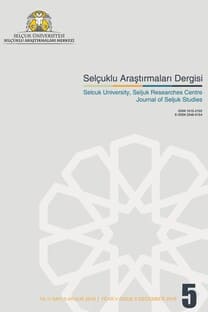AN ANALYSIS ABOUT THE SELJUK ARCHITECTURE
AN ANALYSIS ABOUT THE SELJUK ARCHITECTURE
At the end of the X. century and the beginning of the XI. century, the Oghuzes first moved to the former Khorasan region and then to the center of Iran. Turkmens, who were the founders of the Seljuk dynasty, reached the pinnacle in subjects such as Islam, science, architecture, and art because they ensured political and economic confidence and success in the regions they dominated. Many architectural works such as mosques, madrasas, libraries, cottage houses, and caravanserais were built during the Seljuk period. With the combination of pre-Islamic Iranian art and Islamic art, an architectural style with different features emerged during the Seljuk dynasty period. The Great Seljuk dynasty, which spread over a wide geography, had produced similar architectural works in Anatolian lands, too. Iwan is one of the architectural structures that existed during the Seljuk dynasty and later passed to the Ottoman dynasty. Generally, the courtyard and the places where the outer part of the building is seen as semi-closed are considered features of this period. Due to the climate conditions, the iwan is always located on the outside of the building and is more useful in different seasons of the year compared to the atrium. Another feature of this period is the presence of buffed bricks in the architectural works of the period. Since the lands where the Great Seljuk and Anatolian Seljuk dynasty were established are earthquake areas, the materials used in the architectural works were adjusted accordingly. It is possible to say that Oghuzes were influenced by the materials used inside the tents in terms of shape and interior design since they lived in a semi-nomadic lifestyle before they came to the Khorasan regions. Another feature of the Seljuk period architectural works is the use of minarets. Many minarets were used in the architecture of mosques in the Seljuk dynasty period. In this period, which witnessed different sect conflicts, the construction of mosques and madrasas were more. The reason was the effort to come in contact with the people more than other ideologies. Commercial roads became safer as a result of the trust environment created by the Seljuk dynasty and the caravanserais built as a result of this are a feature that emerges in the architectural works of this period.
___
- Afşar, H. (2018). Sahtarhaye ictima’ı, mühimterin amil şeklgiri borchaye Harakan. Pejüheşhaye bastanşinasi İran, 18, 141-156.
- Âlipur, M. (1395). Şivehaye ecraye arayehaye taz’ini mimari İran der devreye Selcuki. Feslnameye mutaliat-i İranşinasi, 4, 109-135.
- Asğeri, N. (t.y.). Cozvehye mimari İran ve cahan beraye karşenasi erşed. Tahran: Danişkedeye Hünerhaye Ziba Yayınevi.
- Attarzadeh, K. (1394). Harkan Borcha, Adil, G. H., Danişnamehye cahan-ı İslam (C. 15). Tahran: Bunyad-ı Dyıretul Muaref İslami Yayınevi.
- Edrisi Hosrevşahi, N. (1386). Hikmet-ı tez’iynat der hüner ve mimari İslami. Neşriye-yi mimari ve shtiman, 14, 43-46.
- Ettinghausen, R–Grabar, O, (1384). Hüner ve mimari İslami (Ajeng, Y. Çev.). Tahran: Semt Yayınevi.
- Godard, A. (1367). Asar-ı İran (C. IV) (Servkadmukaddam A. Çev.). Meşhed: Bunyad-ı Pejuheşhaye İslami Yayınevi.
- Hambis, L., Margarita C. (1383). Hüner-ı Selcuki ve Harezmi (Ajand, Y. Çev.). Tahran: Moli Yayınevi.
- Haniki, R. (1392). Karvansarahaye Horasan. Tahran: Pejuheşgah Miras-ı Ferhengi Yayınevi.
- Hilmi, A. (1383). Devlet-i Selcukiyan (Tahiri A. N. Çev.). Tahran: Pejuheşgah-ı Hoze ve Danişgah Yayınevi.
- Hoag, Henry, M. (1375). Sebkşinasi hüner-ı mimari der serzeminhaye İslami (Vercavend, P. Çev.). Tahran: İlmi ve Ferhengi Yayınevi.
- Kesayi, N. (1363). Medarıs-ı Nizamiye ve tesirat-ı ilmi ve ictimayi anha. Tahran: Emir Kebir Yayınevi.
- Kiyani, M. Y., Kalis V. (1362). Fihresti karvanserahaye İran. Tahran: Sazman-ı Hifazeti Asar-ı Tarihi İran Yayınevi.
- Maxime, S. (1349). Karvanserahaye İran sahtimanhaye küçek-ı miane rahha (Behnam İ. Çev.). Tahran: Saziman-ı Milli Hefazet az Asar-ı Bastani İran Yayınevi.
- Mazenderani, G. (1394). Mimari müstehkem-ı Selcuki. Domahnameye tefekkür mimari, 42, 82-95.
- Mollazadeh, K. (1378). Mescid-i kırmız-ı saveh. Dairetul muarif binahaye tarihi İran der doran-ı İslami, Pejuheşgah-ı Ferheng ve Hüner-ı İslami, Tahran .
- Motadeyyen, H. (1378). Mescid Çahar İvani. Mecelleye hünerhaye ziba, (C. 6), 84-89.
- Pirniya, M. (1384). Sebkşinasi mimari İrani. Tahran: Suruş-ı Daniş Yayınevi.
- Ruku’i, İ. (t.y.), Serzemin-ı ma (murur-i be tarih ve mimari İran). Tahran: Keyvan Yayınevi.
- Schroeder, E. (1387). Devrey-ı Selcuki, çev: Bakır Ayetullahzadeh şirazi, Der: Arthur Pope ve Ackerman Phılıs, Seyri Der Hüner-i İran Ez Devran-ı Piş Ez İslam ta Emrooz, çev: Mustafa Zakiri-Sadık Melek Şehmirzadı, Zirenezer-ı Siroos-e Perham, C. 3, Tahran: İlmi ve Ferhengi Yayınevi.
- Şekofte, A., Ahmedi, H. & Udbaşi, Ü. (1394). Tezinat-ı acorkari Selcukiyan ve tedavom-ı an der teziynat-ı doran-ı Harezmşahi ve İlhani. Feslnamehye pejuheşhaye mimari İslami, 6, 84-104.
- Selim, G. (1383). Mahmud-ı Gaznevi serağaz-ı vapesgerayi der İran. Tahran: Belh Yayınevi.
- Vercavend, P. (1356). İstimrar-ı hüner-ı mimari ve şehirsazi İran pesez İslam der devran-ı İslami. Mahname hüner ve mardom, 180, 2-19.
- Yusefifar, Ş. (1390). Cestarhayı der munasebat-ı şehr-o şehrneşini der devreye Selcukiyan. Pejuheşgah-ı ulum insani ve motaleat-ı ferhengi, Tahran.
- Zamani, Y. & Abkenari, A. (1396). Vakavi asar-ı mimari ve ikdamat-ı umrani nohostin hükümranan-ı Selcuki ber asas-ı menabe’ mektub ez sal-ı 429 ta 465 H.k. Feslnamehye pejuheşhaye bastanşinasi İran, 12, 227-244.
- ISSN: 1015-2105
- Yayın Aralığı: 2
- Başlangıç: 1986
- Yayıncı: Selçuk Üniversitesi
